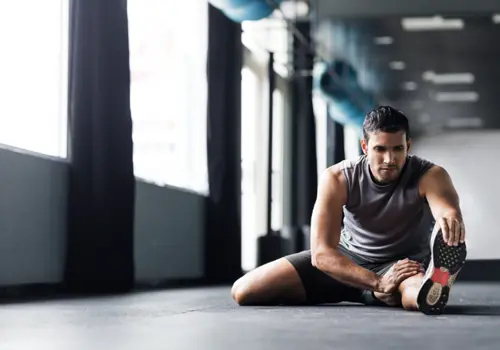Exercises/Workouts • Feb 17, 2025
Why Walking is the Most Underrated Form of Exercise for Your Health
Why Walking is the Most Underrated Form of Exercise
Can it really be as easy as just going for a walk?
When people think of exercise, they often picture intense gym sessions, high-energy spin classes, or long-distance runs. But what if we told you that one of the most effective workouts requires nothing more than a comfortable pair of shoes and a little motivation? Walking is the most underrated form of exercise, yet it offers incredible health benefits that many overlook.
At Svetness, we believe that fitness should be both enjoyable and sustainable. Walking fits seamlessly into any lifestyle, making it an easy yet powerful way to stay healthy. Whether you're looking for structured guidance to maximize your walking workouts or seeking a personalized fitness plan, our personal trainers can help you incorporate walking into your fitness routine for long-term success.
Get ready to rethink the power of putting one foot in front of the other!
Why Walking is the Most Underrated Form of Exercise
Walking is often dismissed as too simple or ineffective compared to high-intensity workouts like running, weightlifting, or cycling. Many people assume that if an exercise doesn’t leave them drenched in sweat or gasping for breath, it must not be doing much for their health. However, this couldn’t be further from the truth: walking is one of the most effective, accessible, and sustainable forms of exercise.
Unlike high-intensity workouts, walking is accessible to almost everyone—no special equipment, gym memberships, or complicated routines required. Whether your goal is weight loss, improved cardiovascular health, or simply staying active as you age, walking is a powerhouse of a workout that deserves more recognition.
The Misconceptions About Walking
So why does walking get overlooked? Here are a few common misconceptions we sometimes hear from our clients (at first)...
"Walking isn’t intense enough to be a workout."
While walking may not have the same calorie-burning intensity as sprinting, it still offers numerous health benefits, including cardiovascular improvements, calorie expenditure, and muscle endurance. A brisk walk as part of your daily routine can still have effects on your cardiovascular fitness—it's still physical activity!
"Walking doesn’t help with weight loss."
Lots of people assume that if an exercise isn’t high-intensity, it won’t contribute to weight loss. However, regular brisk walking can lead to significant weight loss over time, especially when paired with a healthy diet. In fact, walking is one of the most sustainable ways to burn calories without excessive strain on the body. (Learn more about weight loss with Svetness).
"You need to hit the gym to see real fitness results."
While gym workouts are great, walking provides a full-body workout that can be just as effective in maintaining long-term fitness. You could be heading out on your lunch break to get your steps in, pounding virtual pavements on a treadmill, or getting a bit of social activity in as part of a walking group. When incorporated into a structured personal training program, walking strengthens muscles, improves endurance, and boosts heart health.
Why Walking Deserves More Recognition
Unlike many forms of exercise that can be difficult for beginners or those with joint pain, walking is low-impact and inclusive, making it ideal for all ages and fitness levels. A walking routine is an excellent gateway exercise for people looking to start their fitness journey, but it also benefits seasoned athletes by aiding recovery and improving overall endurance.
Additionally, walking fits seamlessly into daily life. You don’t need expensive equipment, a gym membership, or a rigid workout schedule to get its benefits. Whether it's a 10-minute walk after meals, a brisk morning stroll, or power walking as part of an aerobic training routine, walking is a versatile way to stay active.
The Science-Backed Benefits of Walking
Help With Heart Disease
Recent studies have shown that walking has plenty of cardiovascular benefits. A walking program in your daily routine can improve cardiovascular health by reducing the risk of heart disease, raising your energy levels and helping with your overall physical health.
Mental Health Benefits
Professionals in exercise science and medicine have also found plenty of evidence that taking a walk is an underrated form of exercise for your mental health, too. It can reduce anxiety and lead to lower stress levels, raised self esteem and enhanced mental well-being. An APA study found that those who did 2.5 hours of brisk walking per day were likely to experience a 25% lower risk of depression.
Helps You Lose Weight
One of the many benefits of walking is that it burns calories, which in turn helps you lose body fat. It might not be as fast or intense as interval training or sprinting, but it's still exercise! Regular walking with even moderate intensity can be a really underrated exercise for weight loss.
Strengthens muscles, bones, and joints
Regular walking not only enhances cardiovascular health but also plays a crucial role in strengthening muscles, bones, and joints, which can also reduce pain. Engaging in weight-bearing exercise like brisk walking stimulates bone formation and slows age-related bone loss. Additionally, walking helps maintain joint flexibility and reduces the risk of osteoporosis, contributing to overall musculoskeletal health.
Enhances Longevity
Regular walking has plenty of physical benefits, and it also contributes to longevity and reduces the risk of chronic diseases such as diabetes and hypertension. Research indicates that walking at least 8,200 steps per day can significantly lower the risk of developing chronic conditions like obesity, sleep apnea, gastroesophageal reflux disease (GERD), major depressive disorder (MDD), diabetes, and hypertension.
Walking as an Effective Aerobic Exercise
Many people associate aerobic fitness with high-intensity activities like running, cycling, or swimming. However, walking—when done at the right intensity—can be an excellent aerobic workout, offering similar cardiovascular and endurance benefits with much less strain on the body.
How Walking Improves Aerobic Fitness
Aerobic exercise involves sustained movement that increases heart rate and improves oxygen consumption. Brisk walking, defined as walking at a pace of at least 3.5 mph, can elevate heart rate to a moderate intensity, helping to improve lung capacity and oxygen efficiency, strengthen the heart, lower blood pressure, enhance stamina and endurance, and reduce the risk of heart disease and stroke.
Brisk Walking vs. Casual Walking
While any movement is beneficial, the key to turning walking into an effective aerobic workout, just like other forms of exercise, lies in its intensity. Casual strolls are great for mental well-being and joint health, but brisk walking challenges the heart and lungs, leading to greater fitness gains.
To increase intensity, there are a few things to add to a workout. Gradually increase the speed you walk at (aim for at least 3.5-4 mph). Of course, maintain good posture and good form, but also think about incorporating intervals between fast and normal speeds.
Ankle weights are a great way to up the intensity to burn more calories and strengthen your joints, as are weighted vests or resistance bands.
For those looking to maximize aerobic fitness, Svetness offers personalized training to help you incorporate structured walking workouts into your routine. We might start with daily walks, and gradually increase to add in strength training exercises and more. Whether you’re a beginner or looking for more advanced aerobic challenges, a certified trainer can help design a plan suited to your fitness level.
Walking for Different Fitness Goals
Walking isn’t a one-size-fits-all workout—it can be customized to fit a variety of fitness goals. Walking opens up workouts and exercise to a whole variety of people. Whether you’re a beginner starting a new exercise routine, someone trying to lose weight, or an older adult looking to maintain mobility, walking offers tailored benefits for everyone.
For Beginners: The Perfect Starting Point
If you’re new to exercise, walking is one of the easiest and safest ways to get started. It helps build endurance without the intimidation of gym equipment or intense workouts. Beginners can start with just 10–15 minutes a day and gradually increase duration and intensity over time.
For Weight Loss: Burning Calories Effectively
Many people underestimate walking’s role in weight loss, but a consistent walking routine can lead to significant results. Studies show that a 30-minute brisk walk can burn between 150–200 calories, depending on weight and intensity. Over time, this caloric expenditure contributes to fat loss and improved metabolism.
Tips for maximizing weight loss through walking:
- Walk at a brisk pace (at least 3.5 mph) to increase calorie burn.
- Try power walking, where you engage your arms and take longer strides.
- Walk for longer durations (45–60 minutes) to boost fat burning.
- Incorporate inclines or hills for added resistance.
For a structured approach to walking for weight loss, consider Svetness’s weight loss programs, which combine walking strategies with strength training and nutrition coaching.
For Seniors: Maintaining Mobility and Independence
Walking is one of the best forms of exercise for older adults, as it helps improve balance, reduce the risk of falls, and maintain cardiovascular health. A daily walking routine can reduce the risk of osteoporosis, improve flexibility and mobility, lower the risk of chronic conditions like arthritis and hypertension, and boost mental health well-being and cognitive function
For seniors looking to stay active, Svetness offers specialized senior fitness programs that focus on safe, low-impact walking routines.
For Strength & Endurance: Building Long-Term Fitness
Walking can also be used to build muscle endurance and overall strength, particularly when combined with resistance training. Weighted walking (using weights, a weighted vest, or resistance bands) challenges the muscles, helping to improve overall fitness.
Try Nordic walking, which engages the arms using poles, or carry light hand weights while walking. Walk outdoors on varied terrain (such as trails, sand, or hills) to increase resistance and diversity.
How to Make Walking a Daily Habit
One of the greatest advantages of walking is how effortlessly it can be incorporated into daily life. Unlike structured gym workouts that require scheduling and special equipment, walking is something you can do anywhere, anytime. The key to reaping the full benefits of walking is consistency—and turning it into a daily habit can help you stay active without feeling like you’re exercising.
Setting Goals and Tracking Progress
Walking may seem simple, but setting goals can keep you motivated and help you measure progress. Whether you’re walking for weight loss, endurance, or general health, tracking your activity can make a big difference.
If you’re new to walking, start small by aiming for 15–20 minutes per day and gradually increase your duration as it becomes easier. Many experts recommend 10,000 steps per day, but even walking 7,000–8,000 steps daily has been linked to a 50%–70% lower risk of mortality. Using fitness trackers like Google Fit, Apple Health, or Fitbit can help monitor your steps, distance, and pace, making it easier to stay accountable.
Incorporating Walking Into Your Daily Life
If you struggle to find time for dedicated workouts, integrating walking into your existing routine can be an easy solution. Taking the stairs instead of the elevator is a simple yet effective way to add movement to your day while also strengthening your legs and improving cardiovascular health. Parking farther from store entrances or opting for a longer route when commuting by foot can gradually increase your daily step count without requiring extra time in your schedule.
How Svetness Trainers Can Help You Walk With Purpose
While walking is simple, having a structured plan can help you maximize its benefits. A certified trainer, like our Svetness team members, will create a personalized walking plan tailored to your fitness level and goals, ensuring that your walking routine aligns with your overall health objectives.
In addition to designing a structured plan, your Svetness trainer will help you combine walking with strength training and aerobic exercises, making your workouts more dynamic and effective. With expert guidance, you can learn proper walking techniques to prevent injuries and ensure that you’re moving efficiently and effectively.
Structured training can take your walking workouts from simple steps to a well-rounded fitness journey that enhances your health and endurance in meaningful ways.
Whether you’re looking to start small or level up your routine, a structured approach—such as training with Svetness personal trainers—can help you get the most out of your walking workouts
.
Frequently Asked Questions
Is walking enough for weight loss?
Yes, walking can be an effective tool for weight loss, especially when done consistently and combined with a healthy diet. A brisk 30-minute walk can burn around 150–200 calories, depending on your weight and pace. If weight loss is your goal, Svetness trainers can help create a structured walking-based fitness plan tailored to your needs.
How many steps should I walk daily for optimal health?
While the common recommendation is 10,000 steps per day, research suggests that even 7,000–8,000 steps daily can significantly reduce the risk of premature death and chronic diseases. If you’re just starting out, focus on gradually increasing your step count rather than aiming for a specific number right away.
What’s the best way to increase intensity while walking?
To make your walks more effective, you can increase your speed, add incline or hills, incorporate interval walking (alternating between slow and fast paces), or wear a weighted vest. Even walking with light hand weights can help engage more muscle groups.
Can seniors benefit from walking exercises?
Absolutely! Walking is one of the best low-impact exercises for seniors, helping improve mobility, balance, and cardiovascular health while reducing the risk of falls and joint pain. A daily walking routine can also enhance cognitive function and promote mental well-being. For a customized approach, Svetness offers senior fitness programs designed to help older adults stay active, strong, and independent.




